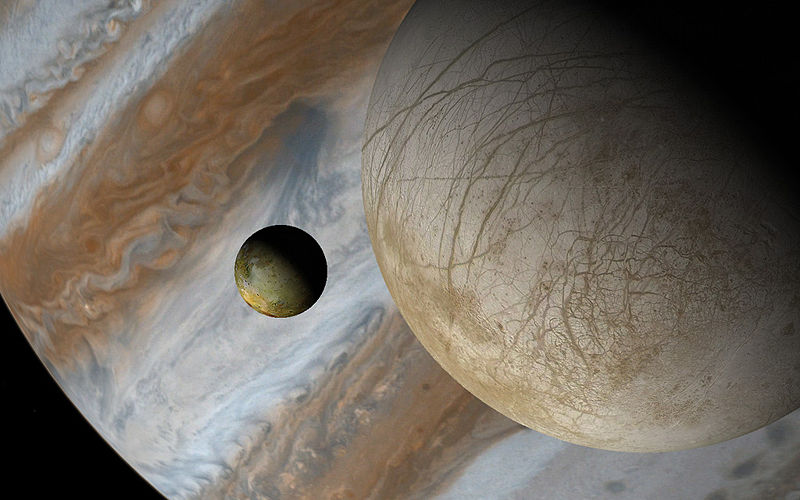Celestia is a 3-D astronomy program created by Chris Laurel. The program is based on the Hipparcos Catalogue (HIP) and allows users to travel through an extensive universe, modeled after reality, at any speed, in any direction and at any time in history. Celestia displays and interacts with objects ranging in scale from artificial satellites to entire galaxies in three dimensions using OpenGL, from perspectives which would not be possible from a classic planetarium or other ground based display.
NASA and ESA have used Celestia in their educational and outreach programs, as well as for interfacing to trajectory analysis software.
Celestia is available for Linux, Mac OS X, and Microsoft Windows. Released under the GNU General Public License, Celestia is free software.
Functions
Celestia users can travel/fly through the Celestia universe using simple keyboard controls, at any speed from 0.001m/s to millions of light years/s. Viewpoints can be set to look forward, backward or at any angle to direction of travel. Controls allow users to orbit stars, planets, moons and other space objects, track space objects such as spacecraft, asteroids and comets as they fly by, or travel to and/or fly through nebula and irregular, elliptical and spiral galaxies (over 10,000 galaxies included).
The time simulated by Celestia can be set at any point in the future or past, although planetary orbits are only accurate within a few thousand years of the present day, and date arithmetic overflows at the year 5874774.
The names and positions of multitudes of objects in space can be displayed, from galaxies, star clusters, nebula, constellations and stars to planets, moons, asteroids, comets and artificial satellites, as well as the names and locations of cities, craters, observatories, valleys, landing sites, continents, mountains, seas and other surface features.
Celestia displays such features as detailed atmospheres on planets and moons, planet shine on orbiting satellites, sunsets and sunrises, moving clouds, planetary rings, eclipse and ring shadows, constellation lines, borders and illustrations, night-side lights, detailed surface textures, specular reflections off water and ice, nebula gases and star flares.
Information about the objects that Celestia draws can also be displayed: the radius, the distance, length of the sidereal day and average temperature of the planets are shown and the distance, luminosity relative to the sun, spectral class, surface temperature and radius of stars are indicated.
The user can change Celestia's field of view from as wide as 120 degrees to a highly magnifying 3.4 seconds of arc, while dividing the window into multiple panes, in order to observe several objects at the same time and including Light time delay if desired.
Graphic screen-shots and movies can be captured in classic or HD resolutions (up to 1920x1080) on Windows and Linux platforms.
Celestia's support for game pads and joysticks is relatively limited, employing many keyboard shortcuts instead.
Celestia can be extended with new objects and there are hundreds of third-party, user-created add-ons available for installation, both fictional and realistic. The extension mechanism uses Lua as its built-in scripting language. Educational lessons and computer lesson plans are available.
After a default install Celestia displays the Hipparcos Catalogue (HIP) of almost 120,000 stars. Celestia uses the very accurate VSOP87 theory of planetary orbits. This makes it possible for it to provide a Solar and lunar eclipse finder and to display the orbital paths of planets (including extrasolar planets), dwarf planets, moons, asteroids, comets, artificial satellites, and spacecraft. The user can vary the number of stars that are visible on the screen and have them drawn in different styles.
Addons
About 18 gigabytes of extensions are available in addition to the base program, produced by an active user community.
High resolution surface textures are available for most solar system bodies, including Virtual Textures with complete coverage up to 32768 pixels wide (1.25 km/pixel at the Earth's equator), with selected coverage at higher resolutions. This allows very close views of the Earth, Mars and the Moon. Many 3D models of historical and existing spacecraft are available flying in reasonably accurate trajectories, from Sputnik 1 and Voyager 2 to the Hubble Space Telescope and International Space Station, as are extended data plots for stars (2 million with correct spatial coordinates). DSOs (nebulae, galaxies, open clusters etc), as well as catalogues of thousands of asteroids and comets and more than 96,000 locations on the Earth can be drawn by the program. Add-ons also include extensive space objects such as red and blue supergiants, red and brown dwarfs, neutron stars, spinning pulsars, rotating black holes with accretion disks, protostars, star nursery nebula, supernova and planetary nebula, galactic redshifts, geological planetary displays (e.g. - 3-D interiors, topographic and bathymetric maps, ice age simulations), planetary aurora, rotating magnetic fields, animated solar flares and prominences, 3-D craters and mountains, and historic collision events. All can be visited via the Celestia travel interface. All stages in the life cycle of stars are available, from nebula stage to black dwarf.
Numerous scripts are available; these include simple tours, reconstructions of complex space missions such as Cassini–Huygens and Deep Impact, and scripts showing useful information, like size comparisons, or particular events such as multiple simultaneous eclipses of Jupiter's moons or the evolution of a star.
Many well known fictional universes are depicted in detail, with whole solar systems and 3D models - films such as 2001: A Space Odyssey, Star Trek and Star Wars, and TV shows including Stargate SG-1 and Babylon 5. Addons illustrating less well known Web fiction, like Orion's Arm, and detailed personal works by members of the Celestia community depicting extensive fictional solar systems with inhabited worlds, spacecraft, cities and exotic special effects can also be obtained.
Educational add-ons (built by and for educators) are also available and are in use worldwide. These activities provide approximately 40 hours of space journeys and astronomical lessons, to include extensive tours of the Celestia universe, the complete life cycle of stars, the solar system, the human space program, the Search for Extraterrestrial Intelligence (SETI), and depictions of astronomical events such as the formation of our moon billions of years ago, and the possible terraforming of Mars in the future. A special educational version of the Celestia program can also provide sound effects and "cockpit" features to simulate flying in a "real" hyperdrive spacecraft.
Celestia Can Be Allot Of Fun.
Celestia provides photo-realistic, real-time, three-dimensional viewing of the solar system, the galaxy and the universe. It is an easy to use, freely-distributed, multi-platform, open source, software package which has become a valuable tool for astronomy education. Used in homes, schools, museums and planetariums around the world, it also is used as a visualization tool by space mission designers. Versions are available for computers running Windows, Macintosh (Mac OS X) and Linux operating systems.
Although it is optimized for 3D astronomical visualization, Celestia can be used to display and explore other 3D environments, too.
And, for some reason, many people seem to find exploring with Celestia to be a lot of fun.
Anime Music Videos only the best on the web, hand picked by an otaku. ~~~~ All videos are purely fan made, with no intent for profit.
Unchained
Nothing like an awesome to MMV (manga music video) to mix things up. Superb editing on this video, never having a still image and run...

-
Nothing like an awesome to MMV (manga music video) to mix things up. Superb editing on this video, never having a still image and run...
-
Not much to say here. Fast, action packed anime music video with a good metal song. The anime looks pretty interesting, after reading...
-
The editor Shin has done it once again, blending just the right song with finely picked clips from just a single anime. Have yet to se...



